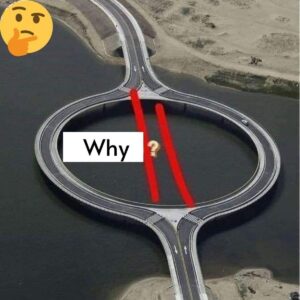1. Traffic Control
-
The round shape acts like a giant roundabout.
-
It slows vehicles down before entering or exiting the bridge, reducing accidents.
-
Especially useful in areas with high-speed traffic approaching from multiple directions.
🌊 2. Waterway Navigation
-
The circle could allow boats or small vessels to pass underneath safely if there’s a navigational channel in the center.
-
A straight bridge might block important paths on the water.
🏗️ 3. Engineering or Terrain Constraints
-
The land or existing roads may not align perfectly.
-
Curved bridges help in adjusting the angles and connecting mismatched roads or terrain on both sides.
🎯 4. Aesthetic or Landmark Purpose
-
Sometimes, it’s simply about creating a visually striking structure.
-
Unusual bridges often become landmarks or tourist attractions.
It’s not always about going the shortest distance — it’s about balancing safety, function, environment, and aesthetics. The red lines in your image illustrate the “obvious” path, but in design, the obvious choice isn’t always the best one!
